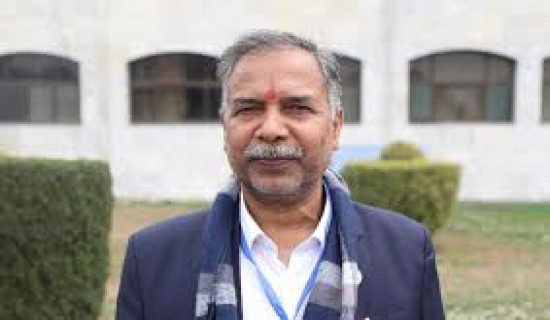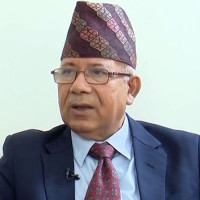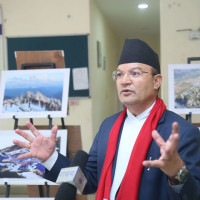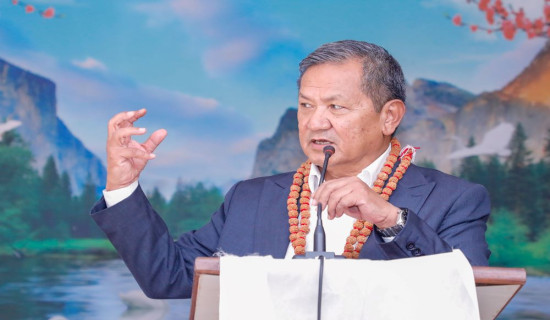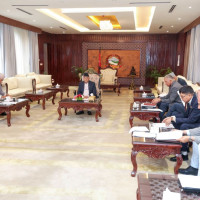- Friday, 6 June 2025
Govt establishes central monsoon response command post Landslides pose bigger threat than floods: NDRRMA
By A Staff Reporter,Kathmandu, June 4: The government has set up a 12-member ‘Monsoon Response Command Post’ led by the Chief Executive Officer (CEO) of the National Disaster Risk Reduction and Management Authority (NDRRMA).
The Command Post was established in accordance with the recently endorsed ‘Monsoon Preparedness and Response National Action Plan– 2025’. As the monsoon has already entered Nepal on May 29, the Monsoon Response Command Post was set up for the first time under the NDRRMA, an authority that runs under the Ministry of Home Affairs.
With the endorsement of the National Action Plan for Monsoon through the executive committee meeting led by Minister for Home Affairs Ramesh Lekhak on May 28, one of the central level monsoon response command posts has been set up, said Under-Secretary and Spokesperson for the NDRRMA Ram Bahadur KC, at a press conference organised to make public the Action Plan-2025 in Singha Durbar on Tuesday.
The Command Post has representatives from the Chief of the Disaster Management Division under the Ministry of Home Affairs, Joint Secretary from the NDRRMA, representatives from the Ministry of Communication and Information Technology, Director General from the Department of Water Resources and Irrigation, Director Generals from the DHM and Department of Roads, representatives from the Nepali Army, Nepal Police, Armed Police Force,
National Investigation Department, and Chief of National Emergency Operation Centre (NEOC) as member secretary of the Command Post.
During last year’s monsoon period, such command post was established just by the Police Headquarters.
Speaking at the press meet, Acting CEO and Joint Secretary Bandhu Prasad Bastola of the NDRRMA said that the NDRRMA though being a young institution of the government, its effectiveness and essence has already been proven during mega level disaster in the country, especially during monsoon season as many human casualties have been minimised compared to the previous year. But, every year, the loss of property caused by the monsoon disaster has been increasing manifold, with the loss of property worth billions of rupees.
During the heavy rain in the month of September last year, the country faced property damage worth over Rs. 45 billion in just two/three days of continuous heavy downpour, he said.
According to Bastola, the Monsoon Response Command Post will handle all disaster-related activities throughout the coming four months of the monsoon period, starting from June to September.
According to the monsoon response command post, it will develop coordination and access all information, data, casualty and loss of property details through the district-level disaster management committee and local emergency operation centres (LEOC) established in every municipality.
“Like every year, our greatest concern is not just rain but landslides caused by relentless rain. Landslides are causing more loss of lives and properties than floods. In this regard, it is essential to have effective plans from the local to the district and central levels, along with accurate and real-time information about the situation of citizens at the local level,” said Bastola.
He said that the NDRRMA has already corresponded for the effective implementation of the Action Plan to all local levels, added Bastola. According to him, this year, the government has also planned to deploy 10,085 Nepal Police officers, 7,615 personnel of the Armed Police Force Nepal and over 7,000 Nepali Army personnel for immediate rescue and relief operations. This year, the APF has separately prepared around 100,000 skilled volunteers to be deployed during the monsoon disasters for immediate rescue and relief.
Disaster preparedness drill performed
Meanwhile, according to Gaighat correspondent Bhakti Bilash Pokhrel, a disaster preparedness simulation was conducted in Gaighat, the district headquarters of Udayapur, to effectively respond to potential threats and ensure efficient search and rescue operations during floods and landslides, as the district is at high risk of flooding.
The artificial flood simulation was carried out in the pond located on the premises of Udayapur Cement Factory of Triyuga Municipality-5.
The event was organised by the Pashupati Prasad Battalion of the Nepali Army based at Pipal Tar Barracks.
According to Battalion Chief Lieutenant Colonel Shiva Kumar Wagle, the simulation was conducted following a decision by the District Disaster Management Committee to enhance preparedness for potential monsoon-triggered incidents such as floods, landslides and inundation.
The drill involved coordinated participation from the Nepali Army, Nepal Police, Armed Police Force Nepal, Nepal Red Cross Society, and various local social organisations active at the community level, all working together under the leadership of the Nepali Army.
During the drill, a scenario was enacted depicting continuous rainfall over two days, causing a diversion of the Saptakoshi River into Belka Municipality, Udayapur.
Security personnel were mobilised to rescue individuals trapped by the floodwaters. A team of military divers used boats to retrieve the victims after about half an hour of effort. The rescued individuals were then given first aid and transported to the hospital by ambulance, as part of the simulated response.



